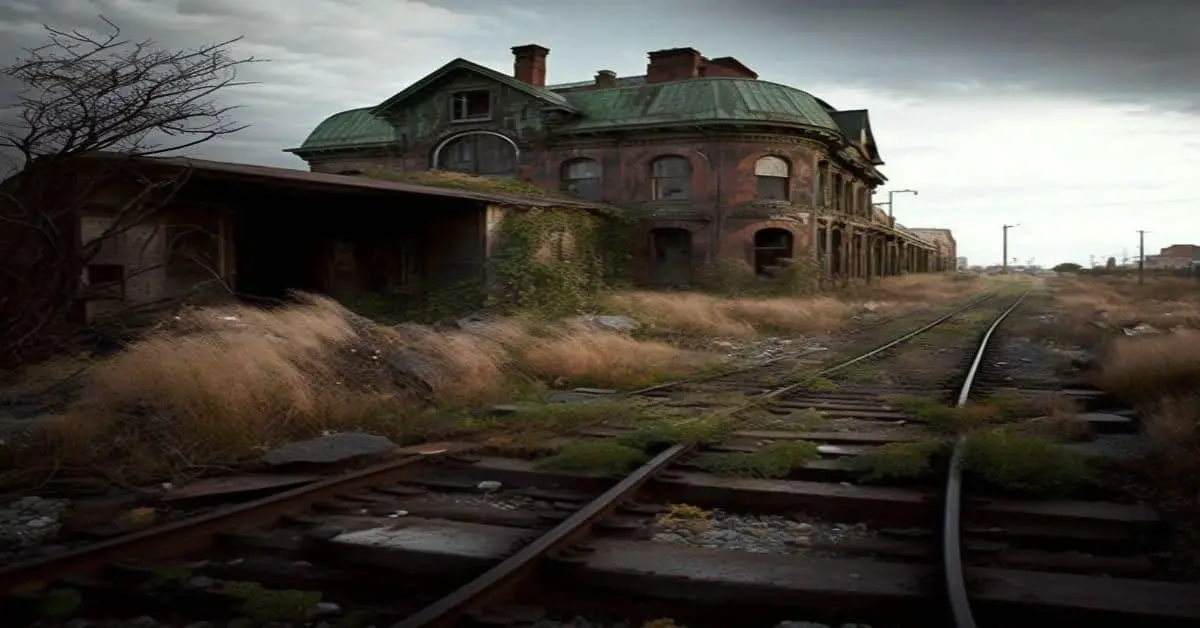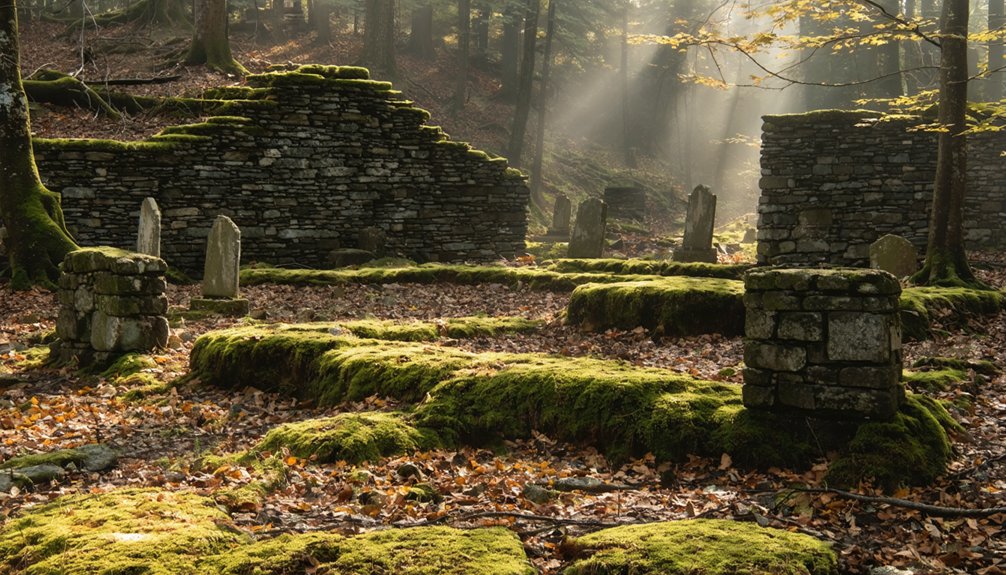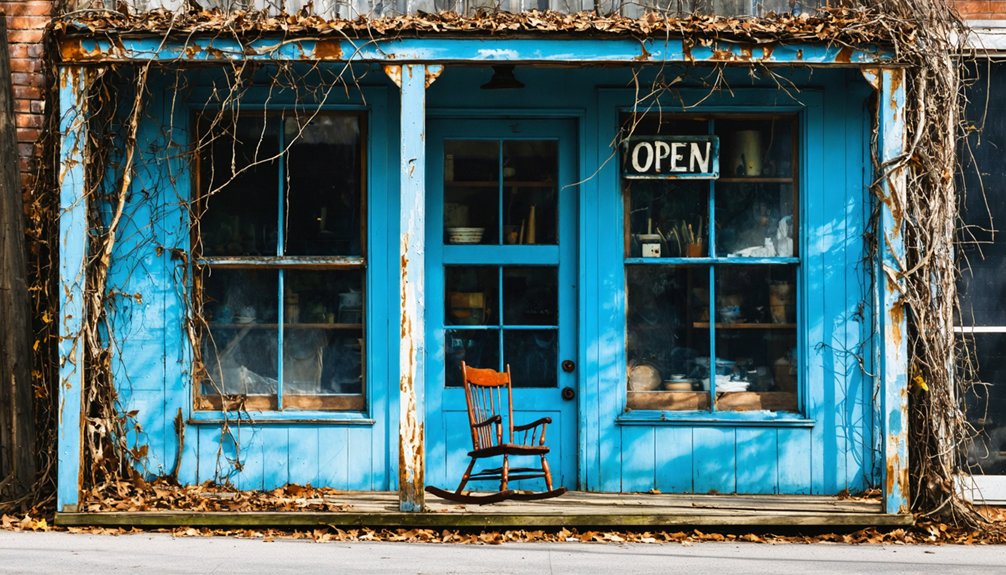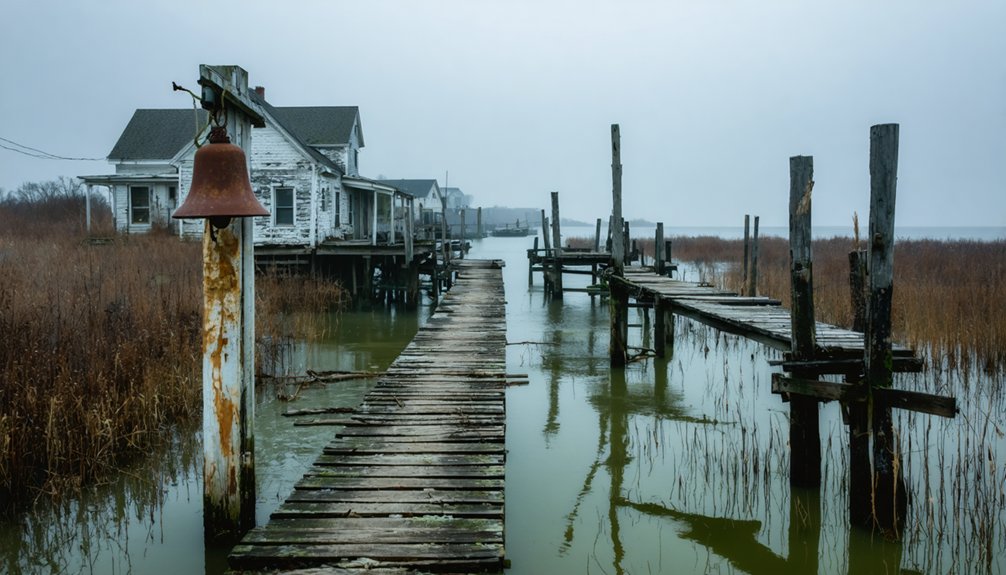Connecticut, the third smallest state, was founded as the fifth state to join the United States on January 9, 1788. With an area of 5,567 square miles, 250 miles of shoreline, and a population of 3.5 million, it is easy to see why there may not be many ghost towns within the state lines.
There are 8 ghost towns in Connecticut. The state has an extensive history from the first settlers to the present day. The ghost towns and historical locations add more adventure and understanding for curious minds.
While the state may not have many ghost towns, it is famous for making history in other ways. In 1895, Connecticut became home to the first hamburger, the first polaroid camera in 1934, a helicopter in 1939, and welcomed color television in 1948.
Bara-Hack, Connecticut
Bara-Hack is located on private property and is currently closed to the public. The forest has overtaken the former fields and streets. A cemetery and the stone foundations remain to be seen of this ghost town, but in 1778 it was a different story.
In 1776, an English colonist, Jonathan Randall, purchased land in Pomfret, Connecticut, but left the area undeveloped until 1778. In 1778, Randall and another colonist, Obediah Higginbotham, fled their homes on the Rhode Island coast after British advances made the area unsafe for settlers. The two families built homes on Randall’s land in Connecticut and established Bara-Hack.
Farming was the small community’s primary income source. Later, a water-wheel-powered mill was constructed, and a business that made spinning wheels to aid in textile production was added to the job list for Bara-Hack residents.
A cemetery was also established to be shared between the Randall and Higginbotham families. Bara-Hack did not have a population boom. The community stayed small enough that it did not even qualify as a village; however, it remained successful as it was for over 100 years. It was not until 1890 that the community was abandoned.
There are myths and rumors of ghosts and hauntings associated with the Bara-Hack grounds, also known as the village of ghostly sounds. Spirits are seen in the great elm tree still on the property, hearing disembodied voices and the sound of horse-drawn wagons traveling on the overgrown main road are a few stories shared about the area.
The land was once open to the public for exploration and paranormal investigation. Due to increased trespassing outside of public hours, the privately owned land is now off-limits to the public.
Dudleytown, Connecticut
Dudleytown is considered a ghost town, but it is not a town. Located a few miles south of the present-day Cornwall Bridge, the village began within a portion of the city of Cornwall. Thomas Griffis was the first to settle the area in the 1740s, followed by several Dudley family members by 1753. Other families moved into the area a few years later.
Before the town was developed as farmland, Dudleytown was forest land. The community’s families worked for generations tilling the land and tending to the crops. Rumors of a curse placed on the Dudley family members explained why the town’s crops failed year after year.
During King Henry VIII’s reign, a man named Edmund Dudley was beheaded for treason, and a curse was supposedly put on any descendants of his. Historians have researched the family line of Edmund Dudley and the Dudleys that resided in Dudleytown but have not found any genealogical link to connect the settlers to the English nobleman. After soil analysis in later years, it was determined poor soil quality was the reason for crop failure, not a curse.
As fertile land was discovered and made available for purchase in the mid-western part of the country, both Dudleytown and Cornwall residents left their current homes to start new lives where agricultural life was thriving. In 1924, Dark Entry Forest, Incorporated purchased the abandoned Dudleytown.
Dark Entry Forest planned to create a place for wildlife to flourish and for people to visit, like a park. Over the next few decades, skiing was popular on Dudleytown Hill during winter. The summer was filled with canoeing down the Housatonic River, horse riding camps for children, picnics, scenic forest trails, and wildlife watching. These were among the favorite activities at the site of the former town.
In the 1980s or 1990s, ghost stories and hauntings from Dudleytown started hitting the news. Many who have visited the area can feel an evil presence that fills the former town. Some individuals refuse to go within the town’s boundaries due to the evilness they feel the closer they get.
In contrast, others believe it is essential to announce their arrival and intentions before entering the town to ensure their safety and confirm that they mean no harm to the spirits.
The forested setting of Dudleytown and the 1999 movie “The Blair Witch Project” drew an increased interest in ghost hunting at the former townsite. Trespassing became a regular activity.
As vandalism started to accompany trespassing, the area was closed to the public. The police have responded to numerous trespassing and vandalism cases, which have resulted in arrests and court prosecutions.
Gay City, Connecticut
Gay City, Connecticut, was founded in 1796 by the religious leader Elijah Andrus, his followers, and John Gay. The first working mill was built in 1800. After additional sawmills and wool mills were constructed, the village was nicknamed Factory Hollow and became home to 25 families. Many families bore the surname Gay, which the village was later named after.
The village would have been set up for success if it had not been for the increased alcohol consumption of religious followers, unpunished murders, and multiple fires that destroyed businesses. Fifteen years after the town was founded, one of the Gay families built their own distillery.
During twice-weekly religious services, followers had free use of alcohol. It was believed consuming alcohol would get the people closer to God, but, in reality, it caused tensions among the residents, and murders went unpunished.
By the end of the War of 1812, the wool mill’s success had ended. In 1830, it was lost to fire for the third time. A paper mill was established to replace the burned-down wool mill, but it, too, was lost to fire. In 1879, the last mill was burned down in a fire.
The village had little left to try and reclaim any success. In 1943, the last descendant of the village sold the property to the state. A year later, in 1944, the state established the land as the Gay City State Park.
The park covers 680 acres and offers fishing, swimming, picnicking, and a campground. It also has a trail system that offers excellent hiking and cycling and a five-mile trail that can be used as a self-guided tour of the entire park. Stone foundations, grass-filled cellar holes, and a few gravestones can be seen where the community once stood.
Johnsonville Village, Connecticut
The mill town of Johnsonville is located in East Haddam, Connecticut. It started as an ordinary milling town until the mid-1800s, when it became the primary twine producer in the area. The Neptune Mill, built in 1832, used the Salmon River as its power source to produce twine and yarn.
The mill produced twine on massive scales, requiring it to reach three stories tall and have a 100-foot-by-100-foot dimension. At the top of the building was a steeple housing a bell that called the mill workers to work each morning. Johnsonville’s twine was used primarily for fishing nets and frequently sold on coasts and the Great Lakes.
In 1846, Emory Johnson, the village founder, constructed a large homestead near the Neptune Mill. In 1862, Johnson built a second mill, the Triton Mill, at the millpond’s northern end. Soon after completing the second mill, the small community grew even more, with worker housing established around the mills. In 1924, the Triton Mill was destroyed in a fire.
In 1965, Raymond Schmitt, the owner of a controversial aerospace equipment manufacturing company, purchased the Neptune Mill, the Johnson homestead, and the 62 acres of land the town was built on. Schmitt planned to transform the milling town into a Victorian-era tourist attraction. Older and Victorian-style buildings were purchased from surrounding towns and transported to Johnsonville to develop further and create the site.
A stable chapel, general store, bank, and a schoolhouse were added to the town, but in 1972, a fire started by a lightning strike at the Neptune Mill destroyed the historic structure. In 1993, Billy Joel’s “River of Dreams” music video was filmed in Johnsonville.
After a dispute between Schmitt and zoning officials in 1994, hopes for the tourism attraction were lost, and the property returned to the market. Sadly, Schmitt passed away just four years later, in 1998.
Meyer Jabara Hotels bought the property in the early 2000s and became the abandoned town’s subsequent owners. The hotel company wanted to reconstruct Johnsonville from an attempted historical tourist attraction to a residential community and bring permanent residents to the townsite.
Unfortunately, reopening the town never happened. Reconstruction plans fell through before they began, and the town was auctioned several times.
National Geographic’s show Abandoned aired an episode showcasing Johnsonville in 2012. In October 2014, Meyer Jabra Hotels entered the property into an online auction. A winning bid of $1.9 million would have removed the company from ownership, but the purchase was never completed.
On July 7, 2017, the Iglesias ni Cristo, a Philippine-based independent Christian organization, officially bought the village for $1.85 million. The organization planned to renovate the structures and establish a center for worship.
Little Danbury, Connecticut
Little Danbury was a beachfront settlement on the Long Island Sound, now present-day southeast Fairfield, used for temporary vacation homes during warm weather. Throughout the majority of the 1800s, temporary shacks would be put up at the beginning of the vacation season and then taken down and stored during the winter months.
In the late 1890s, inexpensive permanent structures resembling beach cottages were constructed and purchased by “average folks” who traveled to the area from Danbury, giving the Little Danbury community its name.
Wealthier vacationers and travelers did not find the beach cottages appealing and would choose to stay at the Fairfield House Resort, which was more inland. To reach Little Danbury, Reef Road was developed. Soon after the road was finished, more permanent structures were built nearby Pine Creek, and the Little Bridgeport community joined the shoreline.
Unfortunately, a category five hurricane in 1938 hit the New England territory and destroyed most of Little Danbury’s homes and property.
Pleasure Beach, Connecticut
Pleasure Beach was established in the 1800s on a two-and-a-half-mile portion of the Connecticut barrier beach. The Pleasure Beach Amusement Park operated from 1892 until 1958. From 1904 to 1919, it was known as Steeplechase Island for a short time until it returned to its original name, Pleasure Beach. Access to the island area was limited to a long walk along the shoreline or ferry travel until a wooden swing bridge was built in 1927.
After a fire destroyed the bridge in 1996, access to Pleasure Beach could only be completed by walking the shoreline or by private boat. Without the bridge, there were fewer visitors to the site. In 2008, Bridgeport was considering a ferry service to offer transportation to the island. Still, the idea fell through due to the parking lots requirements and a Coast Guard registered captain to oversee the ferry operations.
That same year, 45 Pleasure Beach cottages were destroyed in arson attacks, and all the other buildings were heavily vandalized. The former establishment was well known to the homeless, settlers, and risk-seeking partiers who left the area littered and in shambles.
For a while, the city and state spent time and money researching the feasibility of rebuilding the bridge and restoring access to Pleasure Beach, but in early 2009, five more cottages were burned down through acts of arson. By July 2, 2009, the remaining inhabitants had abandoned Pleasure Beach.
By September 2009, the amusement park’s bandstand, carousel, and bumper car area had been demolished without prior permission. Six months later, in March 2010, debris from the cottages began to be removed, paused for the summer to not disturb the seasonal wildlife and their habitats, and continued again in September 2010 until all the debris had been removed.
Any cottages still standing were torn down and removed in May of 2011, leaving a clean and clutter-free beach in place of the residences. The only structures left in a place were the theater and other public buildings that had not been destroyed.
Pleasure Beach reopened to the public in June 2014. A complimentary water taxi, located at the fishing pier on Seaview Avenue, offers transportation to the island seven days a week. The beach also offers a pavilion, relaxation area, bathrooms, showers, picnic tables, and a concession stand.
Pleasure Beach is a protected refuge for endangered birds and plants, including the piping plover, osprey, prickly pear cactus, and southern sea lavender. Sections of the beach will often be roped off during nesting season.
Visitors wanting to spend the day bird-watching and wildlife-viewing will not be disappointed, as there is an abundance of deer, foxes, cotton-tailed rabbits, raccoons, and other mammals.
Bloomfield, Connecticut
Bloomfield is an uninhabited ghost town not far from Windsor, Connecticut. Access to the townsite must be on foot due to the road leading to the former town being closed and blocked off. Walking the path that follows a “Pavement Ending” sign will lead to an overgrown area that was once the town of Bloomfield. All that remains are the footpath and a guardrail.
There are rumors of the headlights of a ghost car driving down the steep, winding, and dangerous road known as “Evil Knievel Road,” but the lights stop at the guard rail. The road was the site of many fatal car accidents during its use.
No records have been found yet, but it is easy to assume that the dangers of the road and the number of lives lost while traveling to and from Bloomfield were one of the primary reasons for abandoning the town in search of a safer and easier-accessible location.
Cuties Island, Connecticut
There is not much information available about Cuties Island. Paul Hurlburt Smart purchased the uninhabited island in 1945. In 1950, Smart finished building a cottage with a stone base and several stone fireplaces inside the house.
Fishermen and campers frequented the area even without permission. In 1959, Smart was on a trip that left the cottage vacant for several months, and unfortunately, it burned down when he mysteriously returned. A few years later, in 1965, Smart sold the island to Paul and Diane Daddona.
Several of the stone fireplaces and the stone foundation remain on the property. To visit Cuties Island, departing by boat from Cove Island at Stamford is the quickest way to reach the destination. There is no land access to travel from the mainland. The south shore of Cuties Island is very rocky, leaving the north shore beach that faces the Connecticut mainland as the ideal place to land.
Little People Village, Connecticut
The stories behind Little People Village will vary from person to person, but there seems to be a common ground they all share, a man who lived in the big house built the little houses throughout the property as well as a large throne, which is quite interesting to see.
One of the most shared stories is that of a man living alone in a forested area when he started to build little houses after hearing voices that told him what to do before he died in his own home.
A second story says the man had a wife who lived with him when he built the little houses after hearing voices and ended up killing his wife on the throne. The third story depicts the man’s wife as a witch who tortured him and ordered the little town’s construction before killing him.
It is not certain what story, if any, is true, but Little People Village was quite an interesting sight before nature reclaimed the land and damaged or destroyed the structures.
The land on which Little People Village was developed is privately owned and is currently off-limits to tourists and visitors. The property owners destroyed the throne to reduce the number of trespassers who tried to access the area.
The foundation and part of the big house are still visible. One of the tiny homes remains intact and has a significant amount of detail that was put into it.
Holy Land USA Amusement Park, Waterbury, Connecticut
In the early 1950s, John Greco envisioned a roadside attraction devoted to God. Greco spent the next few years building a theme park replicating a smaller version of Bethlehem. Alongside Bethlehem, there was a recreation of the Garden of Eden and biblical-themed dioramas that served as tributes to the life and work of Jesus. The park was visited by roughly 50,000 people annually throughout the 1960s.
The park was easily found by the “Holy Land USA” sign and a 56-foot cross that stood tall enough to be seen for many miles. The cross would light up at night, and the sign was noted to resemble the one in Hollywood. Greco wanted to expand the theme park’s site to interest more visitors, so it temporarily closed in 1984 for renovations. Plans for the expansion were never fulfilled, as Greco died in 1986.
A group of nuns was given responsibility for the park. Following Greco’s death, Holy Land USA was frequently vandalized. The nuns tried maintaining the park’s cleanliness but never reopened it to the public.
Local groups of teenagers and foragers beheaded statues, destroyed dioramas, and blocked tunnels within the park. Tourists occasionally stopped to explore the theme park, but nobody stayed for long and made sure they were out of the area before sunset.
While the nuns still owned the property and park, it became more dangerous and was even the site of a murder in 2010. With their safety in mind and the park’s demise, the nuns sold the property, moved away, and “no trespassing” signs were posted across the site.
In 2018, Waterbury Mayor Neil O’Leary and several volunteers worked on renovating the park in hopes of reopening it to the public. The cross from the Holy Land USA sign was replaced with a more prominent cross that can change colors reflecting different holidays. In December 2020, the park was open and operational.
Union Cemetery in Easton, Connecticut
The small town of Easton is home to one of the most haunted places in Connecticut, Union Cemetery. Union Cemetery dates to the 1700s, and while noted as one of the most haunted places in Connecticut, it is also thought to be one of the most haunted cemeteries in the United States.
Due to its popularity for paranormal activity, the cemetery is closed to the public after dusk. City approval is required to gain entry into the cemetery after dark.
There have been numerous accounts of a lady dressed in a light and translucent white nightgown or wedding dress that can be seen roaming through the gravestones at Union Cemetery and the Stepney Cemetery just down the road.
Well-known paranormal investigators, amateur ghost hunters, and regular everyday people with no supernatural investigation history have all claimed to feel the presence of spiritual energy. Several people have pictures and video proof to back their claims of the “Lady in White.” Combined research shows consistency in unexplainable anomalies such as whispers, disembodied voices, and drastic temperature changes.
It is still unconfirmed who the “Lady in White” is after all these years and paranormal occurrences, but there is a theory that Harriet Seeley’s spirit is searching for her son. Harriet was buried in the Union Cemetery after she died at the age of 27.
She had an infant son who died six days before her in 1853, but her grave is a single headstone, and her son is not buried next to her. Perhaps she will find her son one day, and the “Lady in White” can finally rest in peace.
Hookmans Cemetery, Connecticut
Hookmans Cemetery is located in Seymour, Connecticut. The cemetery is smaller than others and is said to be haunted by a man hanging from one of the trees on the grounds. The man who was hung was wrongfully accused of a crime and punished to death. Having been innocent of the crime, the man, known as Hookman, is an angry spirit that roams the area named after him.
Pictures taken in the cemetery have returned with unexplainable clouds and fog from visits on clear nights with no clouds in the sky. Human-like forms can be seen in other pictures, some with faces that are not of those who posed for the photos. The fog has been seen surrounding specific gravestones, but not all of them, and has a darker colored tint to it that regular fog doesn’t have.



